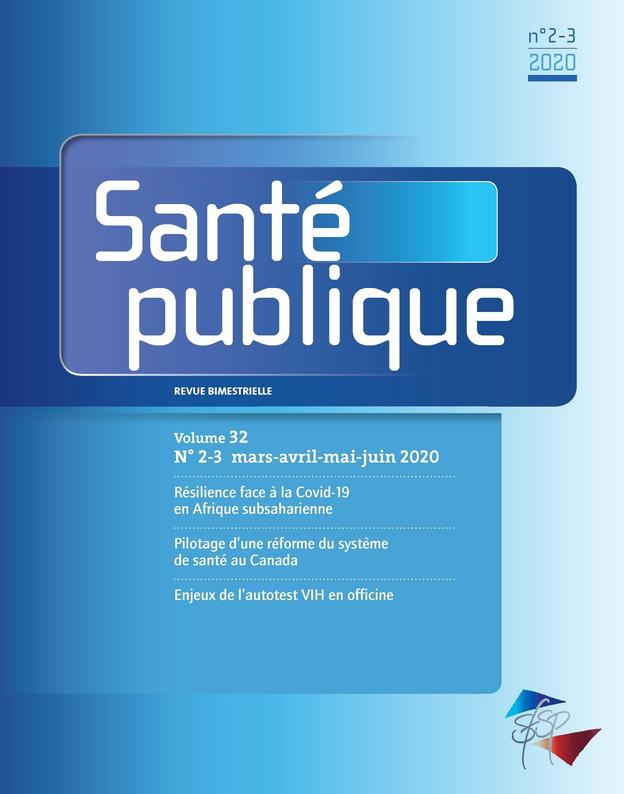Inspq Inspq Center of Expertise and Reference in Public Health Scientific Happy Diet and Active Life, Volume 9, Number 3, September 2021
In this issue:
School environment
Review of existing data on school food policies
Background
School food policies have the potential to respond to increasing the prevalence of overweight, obesity and diabetes, as well as preventing and reducing undernutrition. As part of the preparatory work for the development of new World Health Organization (WHO) guidelines on school food policies, the policy action subgroup of the Expert Advisory Group on WHO nutritional guidelines has carried out a scoping review.
Objective
The study aims to identify the extent of existing evidence from systemic reviews on the effects of school food policies on different health-related factors (e.g., BMI, waist circumference) or not (e.g. food literacy) among school-aged children and adolescents.
What we learn
Finally, 69 systematic reviews on the effectiveness of policies or interventions and on strategies for their implementation were listed and classified according to four areas of actions, namely the school community, the school program, the school food and nutrition environment, and the school nutrition and health services.
This review helps define the scope and focus the guidelines that are being developed. It also identifies gaps in primary studies, including the weak inclusion of theoretical models to guide the implementation of interventions, and the few studies that assess the cost-effectiveness and longer-term effects of interventions.
World Health Organization (2021). Assessing the existing evidence base on school food and nutrition policies: A scoping review.
Facilitators, barriers and solutions for the distribution of fruit and vegetables at school
Context
The distribution of fruit and vegetables in schools is an interesting avenue for familiarizing children to a variety of fruits and vegetables (F and L) and encourage their consumption. A pilot project to this effect is also planned in project 4 of the action plan of the Government of Quebec's Health Prevention Policy.
Purpose
The systematic review includes 24 primary studies. Its objective is to present the success factors of F&V distribution programs in the form of snacks as well as the barriers encountered and the solutions employed.
What we learn
On the one hand, the participation of school staff members is one of the success factors reported. The positive attitude of the teachers seems to particularly motivate the students to participate in the activity and to eat F&V. Carry out a discussion on the F&V offered, involve the teachers in the tasting of F&V and encourage the students to snacking were stated as winning strategies. On the other hand, engaging parents at home through buying F&L, demonstrating food preparation, or discussing with their child(ren) the link between healthy eating and health , would be other success factors.
Various barriers have however been identified, such as the limitation of available funding, storage space and human resources, in addition to food waste. The use of neighboring school premises for storage was mentioned, as was the ordering of F and L whole or already prepared, to solve the problems of space and human resources. Food waste was reduced by slowing the browning of fruit with lemon juice, offering students leftover Fs and Ls the next day, or donating them to staff members or food banks.
The prior identification of success factors and proven effective solutions within the framework of this review could facilitate the implementation of new F&L distribution programs in schools in Quebec.
Ismail, M.R., Seabrook, J.A., & Gilliland, J.A. (2021). Process evaluation of fruit and vegetable distribution interventions in school-based settings: A systematic review. Preventive Medicine Reports, 21, 101281.
Athletes with COVID-19 and NO SYMPTOMS now have myocarditis. Their O2 max and cardiac outputdropped 10%, changing… https://t.co/iByqvakBZc
— Bruce Barnett Thu Sep 03 18:49:51 +0000 2020
Physical Activities
Promising Interventions Targeting Exercise for Older Adults
Background
Demographics are constantly changing globally, increasingly leading to an aging population. Unfortunately, increased life expectancy does not always translate into improved health. Physical exercise is an interesting avenue to ensure that increased life expectancy translates into increased years lived in health, in particular by reducing the risk of falls, increasing metabolic and cardiovascular health, extending the years of independence and promoting the mental health of seniors.
Objective

This systematic review of meta-analyses aims to determine the most promising avenues of intervention for increasing healthy life expectancy in the context of an aging population.
What we learn
In general, we learn that the results vary between the 56 studies selected for this review. The aggregation of the results of the meta-analyses nevertheless makes it possible to identify certain interesting trends that can guide future research or interventions. The three most promising avenues are resistance exercise, active physical activity-oriented video games, and meditative movement interventions (Tai Chi/Qigong, Yoga).
This study seems a priori to emphasize individual interventions to the detriment of population interventions, but this is not the case. The search strategy highlighted a lack of studies that analyzed the effects of interventions on a larger scale, which explains their absence in the reported results. Another variable that seems understudied relates to the professional and social characteristics of the people administering the interventions. Other understudied factors include the impact of motivational strategies and relatives on the outcome of the intervention. The authors therefore conclude that a lot of work remains to be done to better define the elements that will make the success of an intervention aimed at getting older people moving, although their study has made it possible to identify some of them.
Di Lorito, C., Long, A., Byrne, A., Harwood, R. H., Gladman, J. R. F., Schneider, S., Logan, P., Bosco, A., & van der Wardt, V. (2021). Exercise interventions for older adults: A systematic review of meta-analyses. Journal of Sport and Health Science, 10(1), 29-47.
Food environment
Is the food environment linked to obesity?
Background
Causes of obesity, including prevalence remains worrisome in Quebec, are numerous. The food environment, i.e. geographic accessibility to food stores and food, is linked to obesity. The proximity of food establishments offering foods of different nutritional values would influence food choices.
Objective
This Canadian empirical study aims to examine the associations between the food environment accessible within walking distance (500 m) and obesity, using data from 8076 participants from three Canadian cities, namely Quebec, Hamilton and Vancouver. More specifically, taking into account different factors (e.g. age, sex, level of education, etc.), the authors examined the associations between, on the one hand, obesity (BMI) and abdominal obesity. (waist circumference) and, on the other hand, various elements of the food environment, i.e. the ratio of fast food establishments compared to full-service restaurants, the ratio of bars/pubs compared to retail outlets alcohol and the presence of grocery stores.
What we learn
In light of their results, the authors suggest that the food environment should be considered as a whole and in its overall context, rather than by isolating certain of its elements. These results can be used to support the design of health-promoting urban planning policies.
Walker, B. B., Shashank, A., Gasevic, D., Schuurman, N., Poirier, P., Teo, K., Rangarajan, S., Yusuf, S. & Lear, S. A. (2020). The local food environment and obesity: evidence from three cities. Obesity, 28(1), 40‑45.
Promising interventions in supermarkets and grocery stores to encourage healthy food choices
Background
In Quebec, the majority of food purchases are made in supermarkets and grocery stores. grocery stores. Consumers struggle to choose healthy foods, in particular because of the quantity of products offered in these stores. Researchers propose modifying the shopping environment to guide consumers towards healthy choices by modifying the choice architecture. Nudging is a form of choice architecture that also includes food promotion (tasting or nutrition education sessions in-store), price interventions (discounts on healthy foods), proximity (placement of healthy more prominently) and incentive messages (Nutriscore, labeling on the front of the packaging).
Objective
The objective of this systematic review and meta-analysis is to compare the effectiveness of interventions in food stores aimed at encouraging the purchase of healthy foods and beverages. Thirty-six studies conducted only in physical or online food outlets were included. This criterion was put in place to ensure that the effects measured reflect consumer behavior as closely as possible, particularly with regard to price interventions.
What we learn
The results showed that interventions carried out in grocery stores have a small, but significant effect size, especially when they target healthy products. Analysis of in-store interventions shows that price and price combined with promotion or incentive messages had the most impact on shopping behavior. The effect size of in-store interventions was larger when targeting healthy products, for example, fruits and vegetables, than when targeting unhealthy products. The authors believe that, despite their small effect sizes, these interventions are promising because of the prevalence of low-quality diets in the population. In Quebec, the Government Health Prevention Policy includes actions to improve access to healthy eating and the nutritional quality of food. Pricing and promotion strategies inside grocery stores should be explored to complement these actions.
Slapø, H., Schjøll, A., Strømgren, B., Sandaker, I. and S. Lekhal (2021). "Efficiency of In-Store Interventions to Impact Customers to Purchase Healthier Food and Beverage Products in Real-Life Grocery Stores: A Systematic Review and Meta-Analysis", Foods, vol. 10, no 5, p. 922.
Socio-cultural environment
Communicating the consequences of food choices could promote more lasting dietary changes
Background
Food choices are determined by various factors such as taste preferences, health, income and food prices. They play a key role in shaping consumer trends across the population.
Objective
The objective of this non-systematic narrative review was to document the sociocultural factors determining food choices and the intervention strategies intended to improve them.
What we learned
The analysis made it possible to establish the main socio-cultural factors at play in food choices, of which the following is an overview:
Food choices are largely influenced by a variety of social and cultural determinants. For example, business strategies that change the architecture of choice can drive behavior. On the other hand, this type of strategy often works without people knowing. For the authors, a more lasting change in food would imply supporting the possibility of making deliberate choices, while explicitly taking into account the consequences that these choices have on health and the environment.
Enriquez, J.P., and J.C. Archila-Godinez (January 11, 2021). “Social and cultural influences on food choices: A review”, Critical Reviews in Food Science and Nutrition, p. 1‑7.
Built environment
Is perceived food environment associated with prevalence of overweight and obesity among voucher program recipients?
Background< /h4>
The perception that individuals have of the food environment in their neighborhood, in terms of geographical accessibility to food stores and a variety of food on offer, can have an impact on their choices and behaviors food. For people with very low incomes, having recourse to a food aid program such as vouchers, their perceptions of the food environment could partly explain the low quality of their diet and the problems of overweight.
Objective
The authors evaluate the association between the perception of the food environment and the prevalence of overweight and obesity in beneficiary populations of the SNAP (Supplemental Nutrition Assistance) food stamp program. Program) distributed in the United States. The study was conducted with a convenience sample of 1,743 low-income adult participants from six Midwestern US states.
What we learn
The authors draw two main conclusions:
These results are a reminder that food stamp programs must include not only nutrition education to increase individual knowledge about healthy eating and promote healthy behaviors, but also improved physical access to fruits and vegetables. vegetables within the environment that surrounds low-income populations. Beneficiary-dedicated transport solutions are key to addressing physical access challenges ranging from improving physical infrastructure to support active living, to systems to improve communication about available options, including carpooling, discount taxis and food delivery services.
Katare, B., Lynch, K. and D. Savaiano (2020). Perceived neighborhood food environment and overweight and obesity among Supplemental Nutrition Assistance Program-Education (SNAP-Ed) participants in the Midwest US. Public Health Nutrition, 24(4), 729-737.
Writers
Amélie BergeronGabrielle DuretteAnnie GauthierStéphanie LessardJulie Maltais-GiguèreMarie-Claude PaquetteÉtienne PigeonHealthy Eating and Active Lifestyle TeamLifestyles/Healthy Municipalities UnitIndividual and Community Development Branch
Under the supervision of
Éric RobitailleLifestyles/Healthy Municipalities UnitIndividual and Community Development Department
Linguistic review
Sophie MichelDepartment of Individual and Community Development
The inclusion of the articles presented in this newsletter does not imply their endorsement by the Institute. Professional judgment remains essential in assessing the value of these articles to your practice. This monitoring was carried out thanks to the financial participation of the Ministry of Health and Social Services of Quebec (MSSS).










10 Ways to Stay Safe When You Live Alone
Will Belgian workers quit?
Hotels, restaurants: tips paid by credit card will soon be tax-exempt
How to draw a rose: our methods